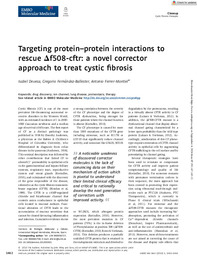Título :
Targeting protein–protein interactions to
rescue Df508‐cftr: a novel corrector
approach to treat cystic fibrosis |
Autor :
Devesa Giner, Isabel 
Fernández Ballester, Gregorio
Ferrer-Montiel, Antonio  |
Editor :
Springer EMBO Press |
Departamento:
Departamentos de la UMH::Bioquímica y Biología Molecular |
Fecha de publicación:
2013-08 |
URI :
https://hdl.handle.net/11000/35277 |
Resumen :
ystic fibrosis (CF) is one of the most prevalent life‐threatening autosomal recessive disorders in the Western World, with an estimated incidence of 1 in 2000–3000 Caucasian newborns and a median age of survival of 40 years. The first report of CF as a distinct pathology was published in 1938 by Dorothy Andersen, a physician at the Babies & Children's Hospital of Columbia University, who differentiated its diagnosis from celiac disease in the pancreas (Andersen, 1938). This seminal description was followed by other contributions that linked CF to altered Cl− permeability in epithelial cells in the gastrointestinal and hepato‐billiary systems, respiratory tract, reproductive system and sweat glands (Kreindler, 2010); and culminated with the discovery of the gene responsible of the disease, referred to as the cystic fibrosis transmembrane regulator (CFTR) (Riordan et al, 1989). The CFTR is a cAMP‐regulated chloride and bicarbonate channel that controls anion conductance in epithelial cells located in mucosal surfaces. Functional alteration of CFTR leads to the accumulation of mucous secretions that cannot be cleared favouring inflammation and infection. Cumulative evidence shows a strong correlation between the severity of the CF phenotype and the degree of CFTR dysfunction, being stronger for those patients where the channel function is absent (Kreindler, 2010).
|
Palabras clave/Materias:
drug discovery
ion channel
lung disease
proteostasis
therapy |
Área de conocimiento :
CDU: Ciencias puras y naturales: Biología: Bioquímica. Biología molecular. Biofísica |
Tipo de documento :
info:eu-repo/semantics/article |
Derechos de acceso:
info:eu-repo/semantics/openAccess
Attribution-NonCommercial-NoDerivatives 4.0 Internacional |
DOI :
https://doi.org/10.1002/emmm.201303301 |
Publicado en:
EMBO Mol Med (2013) 5, 1462–1464 |
Aparece en las colecciones:
Artículos - Bioquímica y Biología Molecular
|
 La licencia se describe como: Atribución-NonComercial-NoDerivada 4.0 Internacional.
La licencia se describe como: Atribución-NonComercial-NoDerivada 4.0 Internacional.
.png)
